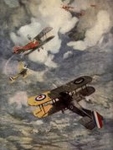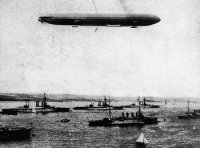
Worksheets and No Prep Teaching Resources
Reading Comprehension Worksheets
World War I

World War I
 Worksheets and No Prep Teaching Resources Reading Comprehension Worksheets World War I |
 World War I |
| edHelper's suggested reading level: | grades 6 to 8 | |
| Flesch-Kincaid grade level: | 7.6 |
|
Balloons As Weapons?
By Jane Runyon |

|
 1 It may sound strange to list balloons as weapons in a war. But we're not talking about the kind of balloons you see at a birthday party or an amusement park. There are much larger balloons capable of carrying passengers and bombs. The first time balloons were used in combat was back in the Civil War. These were usually one passenger hot air balloons used to keep track of the movement of troops. The French also used a limited number of balloons during the siege of Paris in 1870. By the beginning of World War I, technology had advanced the design of the hot air balloon. The Germans called them dirigibles. The dirigibles had a cigar shaped frame of wood and a covering which carried several smaller balloons filled with lighter than air gas. The dirigible carried a lightweight cabin on the bottom of the frame. This cabin carried the steering mechanism used to fly the dirigible. Several small engines were placed around the dirigible to give it power. A hot air balloon could only move in the direction of the wind. The engines and steering mechanism on a dirigible allowed the pilot to go in any direction he wished.
1 It may sound strange to list balloons as weapons in a war. But we're not talking about the kind of balloons you see at a birthday party or an amusement park. There are much larger balloons capable of carrying passengers and bombs. The first time balloons were used in combat was back in the Civil War. These were usually one passenger hot air balloons used to keep track of the movement of troops. The French also used a limited number of balloons during the siege of Paris in 1870. By the beginning of World War I, technology had advanced the design of the hot air balloon. The Germans called them dirigibles. The dirigibles had a cigar shaped frame of wood and a covering which carried several smaller balloons filled with lighter than air gas. The dirigible carried a lightweight cabin on the bottom of the frame. This cabin carried the steering mechanism used to fly the dirigible. Several small engines were placed around the dirigible to give it power. A hot air balloon could only move in the direction of the wind. The engines and steering mechanism on a dirigible allowed the pilot to go in any direction he wished. |
Create Weekly Reading Books
Prepare for an entire week at once! |
| Leave your feedback on Balloons As Weapons? (use this link if you found an error in the story) |
 |
World War I
|
 |
Social Studies
|
 |
United States
|
|
|
|
|
 | Fifty States Theme Unit |
 |
Document Based Activities |